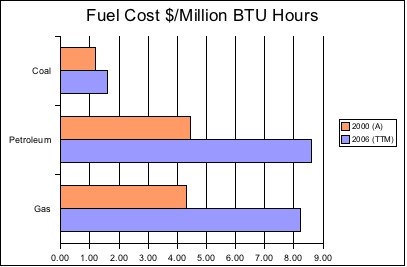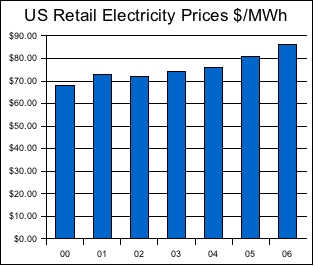Archive for the 'Fossil Power' Category
Attack fossil funding
Not a bad ploy really. The Boston Globe reports that a coalition of environmental groups are doing just that as the Texas Utility Corporation (TXU) seeks $11B for funding the construction of 11 new pulverized coal plants which would release some 78 million tons of carbon monoxide into the atmosphere per year.
What else could one do with $11B of investment? Here’s a list:
- Add 3,600 MW of geothermal power generation (note, this would increase the US geothermal production by 164%) – or –
- Add 9,200 MW of wind power generation (and one could do this in Texas) – or –
- Add 1,375 MW of solar power generation (this could work in Texas too) – or –
- Or if one must do fossil fuel, add 14,600 MW of natural gas power generation
Yes, coal is relatively speaking cheap to acquire, transport, and use. But the cost of the atmospheric impact is huge. Until and unless coal burners have to pay that cost, the true economic impact isn’t being factored in. Even with that, coal prices are up 35% this decade and the rail lines are at (or over) capacity to transport it from point A to point B. Sooner or later, the fact that the fuel is free will make the economics of renewable power generation too attractive to pass up. The environmental benefit will be a nice synergistic effect.
If you liked this entry, Digg It!
Technorati Tags: Coal | Electricity | Funding
Suicide by Coal
According to the American Heritage Dictionary, a suicidal act is one that is “dangerous to oneself or to one’s interests; self-destructive or ruinous.” By this standard, the coal boom that is currently sweeping America is the atmospheric equivalent of a swan dive off a very tall building. At precisely the moment that scientists have reached a consensus that we need to drastically cut climate-warming pollution, the electric-power industry is racing to build more than 150 new coal plants across the United States. Coal is by far the dirtiest fossil fuel: If the new plants are built, they will dump hundreds of millions of tons of carbon dioxide into the atmosphere each year for decades to come — virtually guaranteeing that the U.S. will join China in leading civilization’s plunge into a superheated future.
That’s a quote straight from Jeff Goodell contributor to Rolling Stone magazine. Now I know there are technologies (gasification for instance) that can make coal cleaner than it has been, but that’s still orders of magnitude more polluting than renewable options available. What if, instead of doing “the easy thing” of investing in more coal plants we did “the right thing” and rechanneled that money into renewable plants (a mix of geothermal, wind, biomass, and solar?)
Here’s the thing, according to the US Department of Energy, for each 1,000,000 kwh (1 MWh) of electricity generated by burning coal, 1,000 kg of carbon and around 14 kg of NOx and SOx are released into the atmosphere. Let’s say we make coal 50% less polluting, great. But that would still result in 507 kg of pollutants produced per MWh.
We’re obviously not as smart as we purport to be…
If you liked this entry, Digg It!
Technorati Tags: Energy | Pollution | Coal
$10.5B quarterly profit
Exxon reported $10.5B in profit for their most recent quarter of activity. Another quarterly report, another $10B profit, it’s good to be Exxon. That’s what they call in the business, real money…$1350 profit per second.
If just this quarter of Exxon’s profit was invested in renewable electricity generation using wind, it could fund approximately 10 GW of production leading to around 26 terawatt hours (TWh) (or 26,280,000,000,000 watt hours) of power and that could displace about 26 million kilotons of pollutants annually. This would require the investment of just ONE quarter’s profit.
The economic payback? About 13 years at current electric power prices ($30/MWh net of expenses.)
The lifetime profit? ~$11B.
The public relations and image value? Priceless.
Technorati Tags: Energy | Exxon | Profit
OPEC, cartel extraordinaire
If it wasn’t so sad, it would be funny that many countries with interests counter to the US are profiting immensely from our energy demands. Let’s face it, our appetite for energy in the US is insatiable. As a result, we can as a country be held hostage by those who have the resources necessary to supply our habit and those same people may engage in outright hostile activities toward the US with very little worry of reprisal (with the present situation in Iraq.)
What is the Organization of the Petroleum Exporting Countries (OPEC) anyway? According to the OPEC website it is:
OPEC is a permanent, intergovernmental organization consisting of 11 developing nations, whose economies rely on oil export revenues. One of OPEC’s primary missions is to achieve stable oil prices, which are fair and reasonable to consumers and producers.
If we view the dictionary.com definition of cartel, it states: an international syndicate, combine, or trust formed especially to regulate prices and output in some field of business. Let’s be plain about this, OPEC was founded to be a cartel, has the mission of a cartel, and is a cartel beholden to no one, but it’s 11 member states. Curiously, if the consumers of it’s product were smart enough and had sufficient will to respond to the cartel in an organized and consistent way, they could bring it down. (Other than demanding that the cartel produce more and not charge too much for that right…..which is what these consumers do now.) Why does this cartel have so much power? Because it controls 78% of the world’s proven petroleum reserves (897 billion barrels.)
Just who are the 11 OPEC member states?
- Algeria – Former French colony, now an unstable Arab state, 99% Sunni Muslim
- Indonesia – Former Dutch colony and Japanese possession, now a populous, predominantly Muslim (88%) state
- Iran – Formerly known as Persia, now a militant Islamic state suspected of supporting terrorism globally. Recently has asserted its right to join the nuclear nation club.
- Iraq – We’ve all heard enough about Iraq over the past 16 years.
- Kuwait – Former British colony, compartitively friendly post-liberation from Iraq, predominantly Muslim.
- Libya – Former Ottoman and Italian colony, recently reformed renouncing terrorism and weapons of mass destruction, predominantly Muslim.
- Nigeria – Former British colony, now an unstable African state, about 50% Muslim.
- Qatar – Former British protectorate, now a stable Arab state, predominantly Muslim.
- Saudi Arabia – A stable, Islamic monarchy. 100% Muslim.
- United Arab Emirates – Former British protectorate, progressive state by middle-eastern standards, predominantly Muslim.
- Venuzeula – Former Spanish colony and part of Gran Colombia, now stable socialist state, predominantly Catholic.
What do all these member states have in common? In general, they don’t care much for the US or our policies, but they’re happy to take our money to invest in our ultimate destruction. It’s rare to find such true irony.
By now you might be thinking “well this is depressing.” It is, but doesn’t have to be. With the technologies we have TODAY, we can make the decision to become independent of cartels simply by switching our focus and investment to renewable energy technology, both in electricity generation and in transportation. It can’t happen overnight, but it can happen within 20 years. BTW, what do you think you’ll be paying for a gallon of gasoline in 2026? I’ll bet you’re not saying $2.50…. A funny thing happens to unified producers when their largest, most dependent customer ceases to buy their product – they unravel from the inside out.
We have the ability to disentangle ourselves from this mess, shame on us if we don’t act upon it. The time to start is now.
Technorati Tags: Energy | Oil | OPEC
Fossil fuel costs for electric generation

Data based on Electric Power Monthly Report
As you can see from the graph above, fuel prices have increased rather dramatically for petroleum and natural gas over the past 6 years. It is worth noting that the 2000 numbers are actual average prices (A) and the 2006 numbers are a trailing twelve month average (TTM.) Even coal, not known for price volatility has increased in price 35% during this time period. Petroleum and gas have increased 95% and 91% respectively in the same time period. As previously noted in this entry, coal, petroleum, and gas accounted for 72% of electric power generation in 2005 with coal accounting for the large majority of generation. Gas accounts for 19% of total generation, up 84% from 1992. Petroleum accounts for 3% of generation.
A fair question would be, what has happened to retail prices of electricity during this same period?

Data based on Electric Power Monthly Report
As you can see, retail prices have increased during this same time period, but not close to the rate of increase of fossil fuel cost. Does this mean electric generation companies are going out of business? Rising costs without a commensurate increase in end product cost tends to affect profit in a negative way. One thing is certain, it will be challenging to maintain a competitive business model when fuel costs are a major component of the cost of goods sold. Couple that with increasing regulatory pressures over emissions from oxidizing such fuels setup an interesting challenge for the power generation industry.
Technorati Tags: Electricity | Fossil Fuel | Energy Cost









